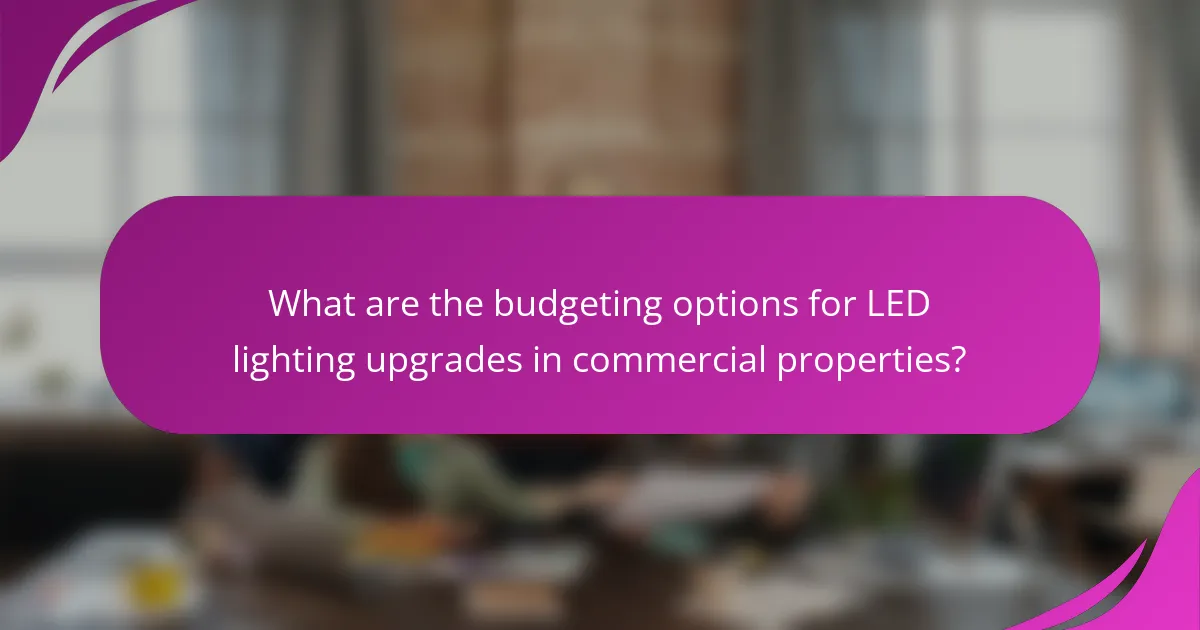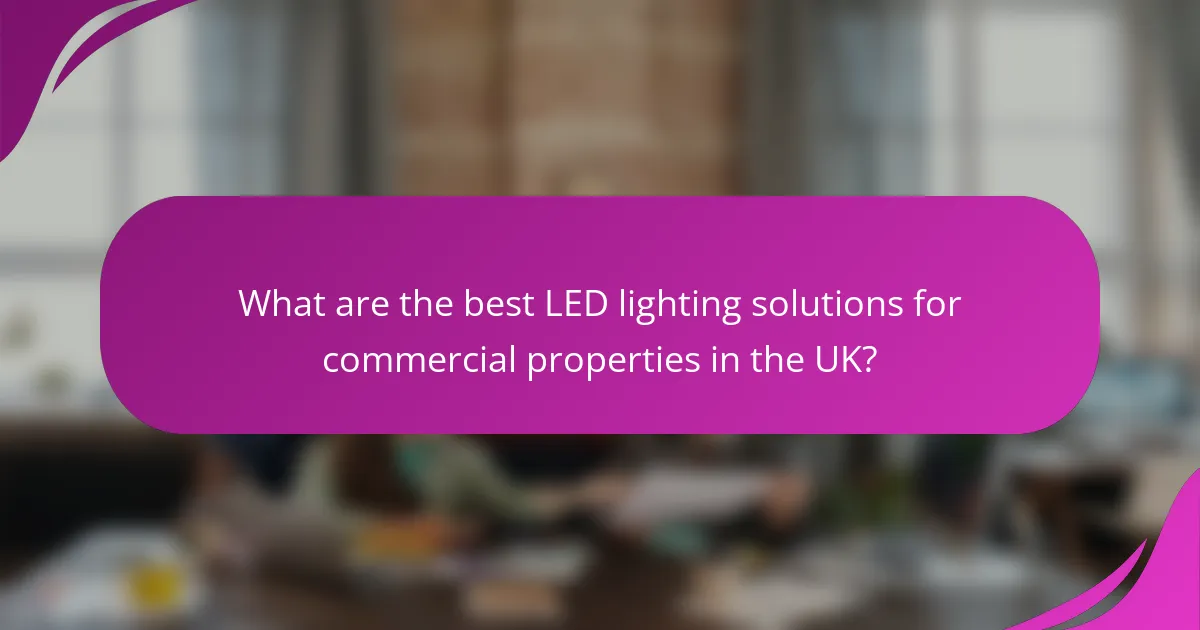Upgrading to LED lighting in commercial properties requires careful budgeting to balance initial costs with long-term savings. By evaluating energy efficiency, maintenance reductions, and available incentives, businesses can make informed decisions that enhance their financial performance. Selecting the right products from reputable brands ensures compliance and optimal functionality, paving the way for a successful transition to more sustainable lighting solutions.

What are the budgeting options for LED lighting upgrades in commercial properties?
Budgeting for LED lighting upgrades in commercial properties involves assessing initial costs, understanding long-term savings, and exploring financing options. Effective planning can lead to significant energy efficiency and cost reductions over time.
Initial investment costs
The initial investment for LED lighting upgrades can vary widely based on the size of the property and the complexity of the installation. Generally, businesses can expect to spend anywhere from a few thousand to tens of thousands of dollars, depending on the number of fixtures and the type of LED technology chosen.
Consider factors such as labor costs, potential need for electrical upgrades, and the price of fixtures. It’s essential to obtain multiple quotes from contractors to ensure competitive pricing and to factor in any potential rebates or incentives offered by local utilities.
Long-term savings on energy bills
LED lighting is known for its energy efficiency, often consuming up to 75% less energy than traditional incandescent bulbs. This reduction can lead to substantial savings on monthly energy bills, particularly for larger commercial properties with extensive lighting needs.
In addition to lower energy consumption, LED lights have a longer lifespan, which means reduced replacement costs. Businesses can typically expect to see a return on investment within a few years, depending on usage patterns and local energy rates.
Financing options available
Various financing options can help businesses manage the upfront costs of LED lighting upgrades. These may include energy efficiency loans, leasing options, or financing through utility companies that offer programs specifically for energy-saving improvements.
Additionally, some government programs provide grants or tax incentives for energy-efficient upgrades. It’s advisable to research local and federal programs to maximize financial support and reduce the overall investment burden.

How can businesses calculate ROI for LED lighting upgrades?
Businesses can calculate ROI for LED lighting upgrades by comparing the initial investment against the savings generated over time. Key factors include energy savings, maintenance cost reductions, and potential incentives or rebates.
Energy savings calculations
To determine energy savings, start by comparing the wattage of existing lighting with the wattage of the proposed LED fixtures. For example, if a traditional bulb uses 60 watts and the LED alternative uses 10 watts, the savings per bulb is 50 watts. Multiply this by the number of bulbs and the hours they are used annually to estimate total energy savings.
Consider local electricity rates when calculating savings. In the U.S., average commercial electricity costs range from $0.10 to $0.20 per kWh. This means that switching to LEDs can yield significant savings, often recouping the initial investment within a few years.
Maintenance cost reductions
LED lights typically have a longer lifespan than traditional bulbs, often lasting up to 25,000 hours or more. This longevity reduces the frequency of replacements and the associated labor costs. For businesses, this can mean fewer maintenance calls and lower overall upkeep expenses.
Additionally, LEDs are more durable and less prone to breakage, which further decreases maintenance costs. When budgeting for upgrades, factor in these savings, as they can significantly enhance the overall ROI of the lighting project.

What are the best LED lighting solutions for commercial properties in the UK?
The best LED lighting solutions for commercial properties in the UK focus on energy efficiency, longevity, and cost-effectiveness. Brands like Philips, Osram, and GE offer a variety of products tailored to meet the specific needs of businesses, ensuring optimal performance and compliance with local regulations.
Philips LED products
Philips offers a wide range of LED lighting solutions suitable for various commercial applications, including office spaces, retail environments, and industrial settings. Their products are known for high energy efficiency and longevity, often exceeding 25,000 hours of use.
Key options include the Philips CoreLine series, which provides versatile lighting solutions with easy installation and maintenance. Additionally, their SmartBright range is designed for cost-effective performance, making it ideal for budget-conscious businesses.
Osram LED solutions
Osram’s LED solutions are designed to enhance both functionality and aesthetics in commercial properties. Their product line includes options like the Osram LEDVANCE series, which offers high-quality lighting with a focus on energy savings and low maintenance costs.
Businesses can benefit from Osram’s tailored solutions, such as the DALI (Digital Addressable Lighting Interface) systems, which allow for advanced control and automation of lighting, improving energy efficiency and user comfort.
GE LED lighting options
GE provides a variety of LED lighting options that cater to different commercial needs, from warehouses to retail spaces. Their LED products are designed for durability and efficiency, often featuring integrated smart technology for enhanced control.
The GE Lumination series, for example, offers flexible designs that can be customized for specific applications, while their energy-efficient options can lead to significant savings on electricity bills. Businesses should consider the long-term benefits of these solutions when planning their lighting upgrades.

What factors should be considered when selecting LED lighting?
When selecting LED lighting for commercial properties, key factors include brightness, energy efficiency, and compatibility with existing fixtures. These elements significantly impact both the performance and cost-effectiveness of the lighting upgrade.
Brightness and color temperature
Brightness is measured in lumens, and selecting the right level is crucial for different commercial settings. For example, offices typically require around 300-500 lumens per square meter, while retail spaces may need higher levels to enhance product visibility.
Color temperature, measured in Kelvin (K), affects the ambiance of a space. Warmer temperatures (2700K-3000K) create a cozy atmosphere, suitable for restaurants, while cooler temperatures (4000K-5000K) are often preferred in work environments for better concentration.
Energy efficiency ratings
Energy efficiency ratings, such as the Energy Star label, indicate how much energy an LED light consumes relative to its output. Choosing lights with high efficiency can lead to significant savings on electricity bills, often reducing costs by 50% or more compared to traditional lighting.
When budgeting for upgrades, consider the long-term savings from energy-efficient LEDs. Although the initial investment might be higher, the return on investment (ROI) can be realized within a few years through lower utility costs.
Compatibility with existing fixtures
Before purchasing LED lights, assess whether they are compatible with your current fixtures. Some LEDs are designed to work with specific types of fixtures, while others may require adapters or modifications.
Additionally, consider the dimming capabilities of your existing systems. Not all LED lights are dimmable, and using non-dimmable LEDs with a dimming system can lead to flickering or reduced lifespan. Ensuring compatibility can save time and additional costs during installation.

What are the local regulations for LED lighting in commercial properties?
Local regulations for LED lighting in commercial properties typically focus on energy efficiency, safety, and environmental impact. Compliance with these regulations is crucial for property owners to avoid penalties and ensure sustainable practices.
UK energy efficiency standards
In the UK, energy efficiency standards for LED lighting are guided by the Energy Savings Opportunity Scheme (ESOS) and the Energy Efficiency (Private Rented Property) (England and Wales) Regulations. These standards encourage the use of energy-efficient lighting to reduce carbon emissions and lower energy costs.
Commercial properties are often required to meet minimum energy performance benchmarks, which can vary by building type and usage. Upgrading to LED lighting can significantly improve energy efficiency, often resulting in savings of 50% or more compared to traditional lighting solutions.
Building regulations compliance
Building regulations in the UK mandate that all lighting installations, including LEDs, must adhere to safety and performance standards. This includes ensuring that lighting systems are properly installed and maintained to prevent hazards such as electrical fires.
Property owners should consult the latest Building Regulations, particularly Part L, which covers conservation of fuel and power. Regular audits and compliance checks can help ensure that lighting upgrades meet these regulations, ultimately protecting both the property and its occupants.

How can businesses ensure a smooth transition to LED lighting?
Businesses can ensure a smooth transition to LED lighting by carefully planning the installation process and selecting qualified contractors. These steps help minimize disruptions and ensure that the upgrade meets both operational and regulatory standards.
Planning installation timelines
Effective planning of installation timelines is crucial for a seamless transition to LED lighting. Businesses should assess their operational schedules to determine the best times for installation, ideally during off-peak hours to minimize disruption. A typical upgrade might take anywhere from a few days to a couple of weeks, depending on the size of the property.
Creating a detailed timeline that includes milestones and deadlines can help keep the project on track. Consider factors such as delivery times for LED fixtures and any necessary permits or inspections that may be required by local regulations.
Choosing qualified contractors
Selecting qualified contractors is essential for a successful LED lighting upgrade. Look for contractors with experience in commercial lighting projects and positive reviews from previous clients. Verify their credentials and ensure they are familiar with local building codes and energy efficiency standards.
Request multiple quotes to compare pricing and services. A good contractor should provide a clear breakdown of costs and timelines, helping you make an informed decision. Avoid choosing solely based on the lowest bid, as quality and reliability are critical for long-term satisfaction with the upgrade.

What are the common misconceptions about LED lighting upgrades?
Many misconceptions surround LED lighting upgrades, particularly regarding their cost, performance, and longevity. Understanding these misunderstandings can help commercial property owners make informed decisions about their lighting investments.
Cost vs. benefits misunderstanding
A prevalent misconception is that the initial cost of LED lighting is prohibitively high compared to traditional lighting options. While it’s true that LED fixtures can have a higher upfront price, their long-term savings on energy bills and maintenance often outweigh these initial expenses.
For example, LED lights can consume up to 80% less energy than incandescent bulbs, leading to significant reductions in utility costs over time. Additionally, their lifespan can exceed 25,000 hours, reducing replacement frequency and associated labor costs.
Performance myths
Another common myth is that LED lighting does not provide adequate brightness or color quality compared to traditional lighting. In reality, modern LED technology offers a wide range of brightness levels and color temperatures, making it suitable for various applications.
Commercial properties can benefit from LEDs that provide high lumen output and excellent color rendering, ensuring that spaces are well-lit and visually appealing. Furthermore, advancements in LED technology have improved dimming capabilities, allowing for greater control over lighting environments.


